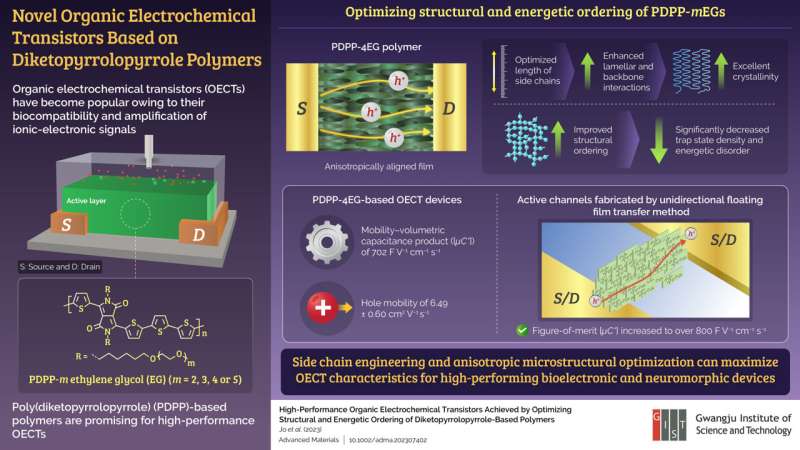This article has been reviewed according to Science X's editorial process and policies. Editors have highlighted the following attributes while ensuring the content's credibility:
fact-checked
peer-reviewed publication
trusted source
proofread
Researchers optimize the performance of novel organic electrochemical transistors

Organic electrochemical transistors (OECTs) have recently received a lot of interest and attention in the research community, not only for their biocompatibility but also for other novel characteristics like the amplification of ionic–electronic signals and the detection of ions and molecules.
To achieve these characteristics, semiconductors comprising OECTs must be able to transport both ions and electrons efficiently. Conjugated materials grafted with hydrophilic glycol chains have shown desirable levels of efficiency while also being soft and allowing ions to permeate through their surfaces. However, they exhibit imperfect semicrystalline characteristics and disordered fractions when converted into solid films.
The steady-state performance of OECTs can be optimized by using both molecular design and structural alignment together to reduce the energetic and microstructural disorders in the films. With this forethought, a group of researchers led by Professor Myung-Han Yoon from Gwangju Institute of Science and Technology, Korea, has recently undertaken a study to create high-performance OECT devices based on poly(diketopyrrolopyrrole) (PDPP)-type polymers as active layers.
They modulated the number of repeating units of ethylene glycol (EG) side chains in PDPP from two to five and chose the figure-of-merit as the product of the charge carrier mobility and the volumetric capacitance. Their study was made available online in Advanced Materials.
Talking about the rationale behind conducting this study, Prof. Yoon says, "Using mixed conductors in electrochemical transistors makes it difficult to expect significant performance improvements, even when applying conventional microstructure control processes."
"This is due to the strong intermolecular cohesion owing to the flexibility and hydrophilicity of the molecular structure side chains. Our new mixed conductor material solves this problem by introducing alkyl-EG hybrid side chain structure, which can provide appropriate hydrophobicity and structural stability to the molecule."
In their study, ultraviolet-visible (UV-vis) absorption spectroscopy confirmed the formation of J-aggregates in the three, four, and five EG polymers. Moreover, cyclic voltammetry measurements demonstrated a gradual decrease in oxidation onset values with an increase in the number of EG polymers.
Furthermore, since electrochemical impedance spectroscopy revealed similar volumetric capacitance values for all polymers in the present PDPP family, the researchers utilized charge carrier mobility to primarily distinguish their performance.
The OECT device based on PDPP-4EG fabricated via spin casting showed optimal performance—a figure-of-merit value of 702 F V-1 cm-1 s-1, charge carrier mobility of 6.49 cm2 V-1 s-1, and a transconductance value of 137.1 S cm-1.
The subthreshold swing values were as low as 7.1 V dec-1, and the number of interface trap states were only 1.3 x 1013 eV-1 cm-2. Furthermore, PDPP-4EG also exhibited the lowest degree of energetic disorder and well-developed crystalline domains with the least microstructural disorder.
To optimize structural alignment along the OECT channel, the researchers utilized the unidirectional floating film transfer method (UFTM). The J-aggregates underwent unidirectional compression when the polymer film was added to a hydrophilic liquid. The UFTM PDPP-4EG film-based OECTs yielded a remarkable figure-of-merit value of over 800 F V-1 cm-1 s-1.
Highlighting the long-term implications of this study, Prof. Yoon says, "In the era of artificial intelligence, neuromorphic devices are expected to be developed. Organic mixed conductors are among the most promising materials in this field, with high potential for advancement. Our research forms a part of the efforts to overcome the low performance of organic materials."
In the long term, the development of organic mixed conductors with high reliability can be applied to various fields, such as next-generation wearable sensors, computers, and health care systems, thus contributing to the enhancement of human convenience.
More information: Il‐Young Jo et al, High‐Performance Organic Electrochemical Transistors Achieved by Optimizing Structural and Energetic Ordering of Diketopyrrolopyrrole‐Based Polymers, Advanced Materials (2023). DOI: 10.1002/adma.202307402
Journal information: Advanced Materials
Provided by Gwangju Institute of Science and Technology




















